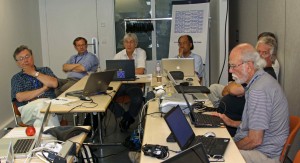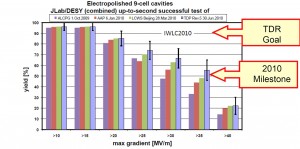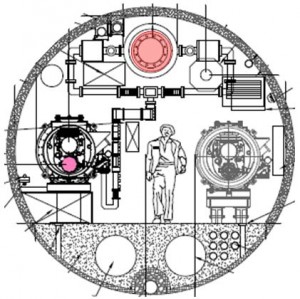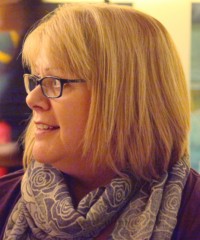
GDE Executive Committee members Peter Garbincius, Brian Foster, Jean-Pierre Delahaye, Toshiaki Tauchi, Mike Harrison (partially hidden) and Barry Barish during a working session at ICHEP 2010 in Paris
The ILC is still very much a dream and the path to a real project remains highly uncertain, even though the scientific case is as strong as ever and we continue to meet all our highest priority goals. Hopefully, the world political and economic climate will improve before too long and there will once again be receptiveness to major investments in large-scale basic science projects. It is hard to imagine that we have seen the last of such projects; therefore our strategy is to be as prepared as possible to make a strong proposal for a linear collider when the time is right. Keeping that ultimate goal in mind, how are we doing and what did we accomplish in 2010? In fact, in my opinion, last year was a banner year for the Global Design Effort!
We continue to appreciate the support we get from Fermilab in hosting our small central administrative offices, from which we are able to very effectively organise and support our widespread activities, whether organising meetings, hosting linearcollider.org and ILC NewsLine, providing web services, providing purchasing, assisting travel, etc. The scientific and technical work of the GDE is coordinated by the Executive Committee (EC), composed of senior members from around the world. It is very active and works very well, whether coordinating our scientific and technical programmes or making policy decisions. This group deserves much of the credit for our successes, which result from their dedication, hard work and good advice.
The central mission and mandate of the GDE is to coordinate the worldwide R&D programme and to produce a technical design for the ILC by the end of 2012 that has a worldwide consensus behind it. In addition, our R&D programme is focused on demonstrating the key technical features in the design. After two years, we have evolved the original reference design to one better optimised for cost, performance and risk and have succeeded in accomplishing much of the key R&D.

Production yields of ILC cavities, where most recent data proves that the ILC milestone of 50% yield for cavities was achieved
Perhaps our most important accomplishment last year was to achieve our ambitious intermediate goal of producing high-gradient superconducting radiofrequency (RF) cavities of 35 megavolts per metre (MV/m) with 50% yield. Now, we are concentrating on developing cost-effective production processes with industry and further improving the cavity gradient and yield.
The second major R&D accomplishment during 2010 was the studies of electron cloud effects in CesrTA at Cornell. This experimental programme is providing measurements that will be very important for a wide variety of future accelerator applications. Specifically for the ILC, CesrTA is giving us the crucial information to determine our electron cloud mitigation strategy.
During 2010, we also turned on the ATF-2 beam at KEK and this accomplishment represents the beginning of the crucial ILC final focus performance studies. One of the unique and most crucial features of the ILC is the very small beam sizes at the interaction point. We anticipate important results from ATF-2 in 2011 and 2012.
The ILC design effort has also made big strides during 2010. The GDE project managers identified and proposed a selected set of design changes more than one year ago. After many meetings, reviews, and further work, two major changes have now been adopted for the Technical Design Report baseline: a change from a double to a single tunnel for the main linac and the establishment of the operating gradient (31.5 MV/m) for the main linac, which was discussed by the community at the first baseline assessment workshop (BAW-1) at KEK in September. These two changes were formally proposed to me last autumn, and with the assistance of a baseline assessment group, they were evaluated and I approved them.

Layout of a single-tunnel ILC main linac for one of two schemes being pursued for high level RF distribution (Klystron Cluster Scheme).
Similarly, the same final steps (BAW-2, etc) for the remaining two major changes to the baseline design are taking place over the next month or so. Following those decisions, we will be ready to concentrate our efforts on the design work and costing for the TDR.
In today’s ILC Newsline’s Research Director’s Report, Sakue Yamada addresses our progress on physics and detectors. He discusses the change of representative for the European World Wide Study (WWS) leader from François Richard to Juan Fuster. I would like to comment on this change, by adding my hearty thanks to Francois for his tireless advocacy of the ILC, critical approach and great energy. We will miss him in the WWS role, but I am sure his voice will continue to be heard loud and clear. Besides, Francois still owes me for a bet that he didn’t mind losing to me regarding our estimates of the level of participation at IWLC 2010 and I fully intend to collect! I also welcome Juan Fuster. Juan has been instrumental in bringing the Spanish ILC effort to a reality and we look forward to using his many talents in a broader role.
In conclusion, I want to emphasise that we remain firmly on course to complete our TDR by the end of 2012, as we have promised. Let’s just hope that exciting early LHC results and an improved world economic situation will combine to enable the changing of our dream to a reality.GDE



Recent Comments